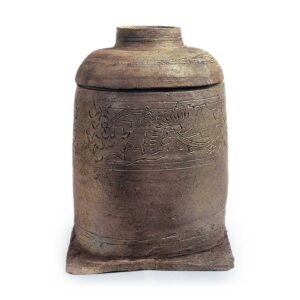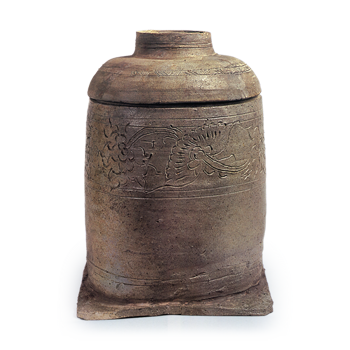
12th century
(Lid) Height 8.5cm, Diameter 22.2-23.1cm (Body) Height 26.6cm, Bowl diameter 21.0cm, Body diameter 24.2cm, Bottom diameter 25.2cm
Aichi Prefectural Ceramic Museum
This is exactly the same type as the sutra case outer vessel shown in Sanage Sutra Case Outer Vessel, and was probably excavated from the same site. The body is divided into three parallel sunken lines, and a bird’s-eye view of peony petals is drawn between the upper two lines, from which vines are derived to form a series of side views of petals. The technique of painting with a sunken line is a Japanese technique that has been used since the Heian period (794-1192), but the pattern of large peony patterns between the sunken lines is an imitation of Chinese Song dynasty celadon and white porcelain.
. As mentioned in Figure 117, a large jar fragment with a similar design was excavated from Higashiyama Kiln No. 105 in the Higashiyama Botanical Garden in Nagoya City. The same kiln was used for this piece. This type of inlaid floral design was a popular decorative technique at the Sanage kilns from the late 10th century onward, but it was discontinued in the middle of the 11th century, and it is significant that it reappeared in the early 12th century, as in the case of this vessel. While the previous design was an imitation of the four-petaled floral motifs of the late Tang dynasty and the Five Dynasties, this new floral pattern and expression technique is clearly of the Song dynasty, and we can see the change in the bearers of the floral motifs in the pottery as it is again being fired in imitation of Chinese ceramics. Needless to say, this is the beginning of the medieval style, and can be regarded as the first manifestation of the patterns that continued into the Kosedo period.



